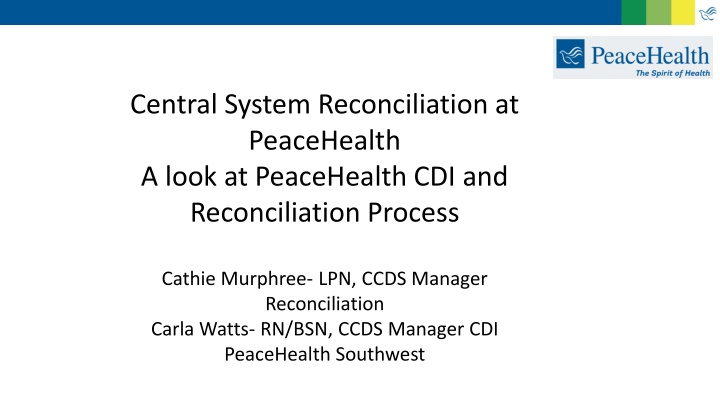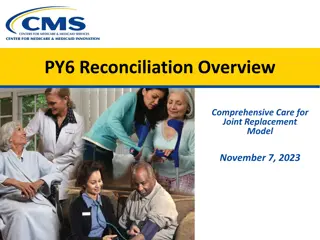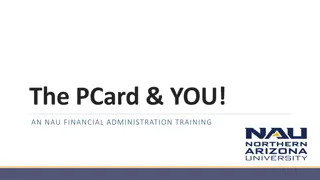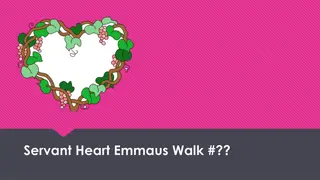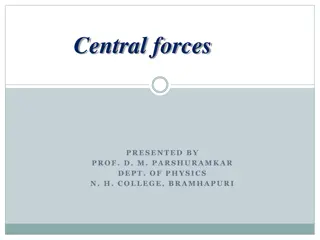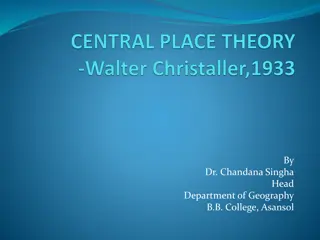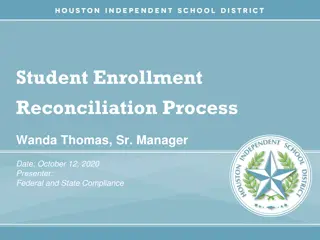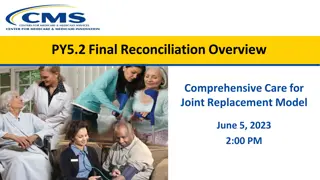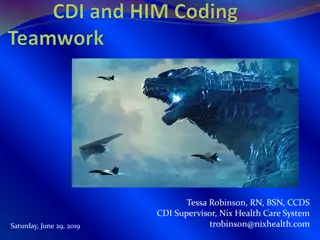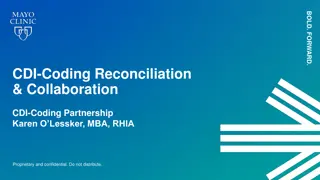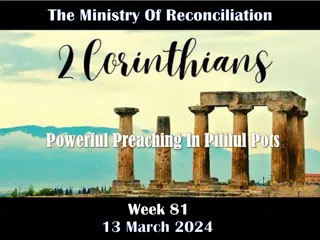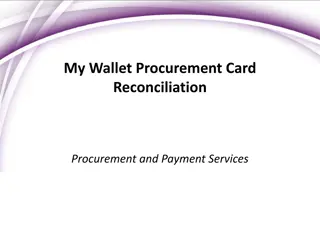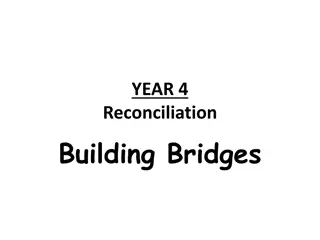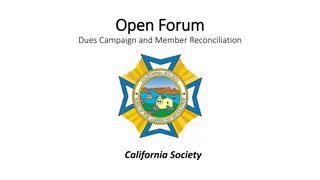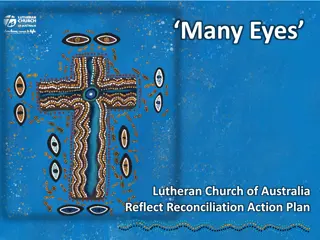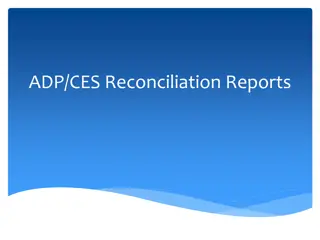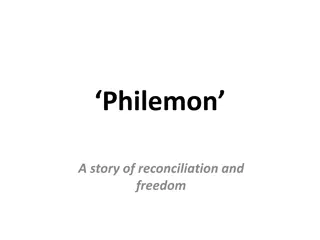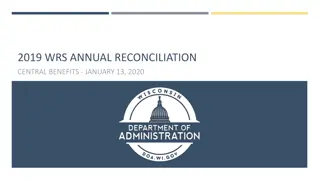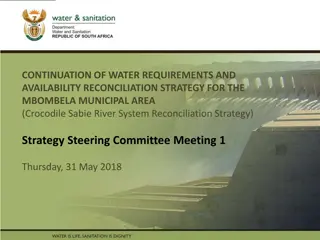The Central Reconciliation Process at PeaceHealth System
Explore the central reconciliation process at PeaceHealth, where a dedicated team collaborates with CDI and coding professionals to ensure data integrity. Learn about the objectives and benefits of having a reconciliation team in a multi-hospital system. Discover how reconciliation improves documentation accuracy and identifies educational needs. PeaceHealth consists of a Central Shared Service Center and multiple hospitals in the Pacific NW.
Download Presentation

Please find below an Image/Link to download the presentation.
The content on the website is provided AS IS for your information and personal use only. It may not be sold, licensed, or shared on other websites without obtaining consent from the author.If you encounter any issues during the download, it is possible that the publisher has removed the file from their server.
You are allowed to download the files provided on this website for personal or commercial use, subject to the condition that they are used lawfully. All files are the property of their respective owners.
The content on the website is provided AS IS for your information and personal use only. It may not be sold, licensed, or shared on other websites without obtaining consent from the author.
E N D
Presentation Transcript
Central System Reconciliation at PeaceHealth A look at PeaceHealth CDI and Reconciliation Process Cathie Murphree- LPN, CCDS Manager Reconciliation Carla Watts- RN/BSN, CCDS Manager CDI PeaceHealth Southwest
Objectives Learn how reconciliation works in a multi-hospital system Gain insight into a how a reconciliation team functions in collaboration with CDI and Coding Pro s and Con s of having a central reconciliation team How having a reconciliation team can help improve integrity of the data How having a reconciliation team aids in highlighting educational needs by site
Polling Question 1 H o w m a n y o f y o u w o r k a t a f a c i l i t y w h e r e t h e r e i s a o f f i c i a l R e c o n c i l i a t i o n P r o c e s s ? ? W h o d o e s t h e R e c o n c i l i a t i o n ? o N o R e c o n c i l i a t i o n i s D o n e o C o d i n g ? o C D I ? o M a n a g e r f o r C o d i n g , C D I o r B o t h ? o D e d i c a t e d R e c o n c i l i a t i o n Te a m
What is Reconciliation? R e c o n c i l i a t i o n i s t h e p r o c e s s o f r e v i e w i n g m e d i c a l r e c o r d d o c u m e n t a t i o n a n d c o m p a r i n g t h i s i n f o r m a t i o n t o t h e c o d i n g s u m m a r y : p r i n c i p a l d i a g n o s i s , s e c o n d a r y d i a g n o s e s , p r e s e n t o n a d m i s s i o n i n d i c a t o r s , p r o c e d u r e ( s ) , a n d d i s c h a r g e d i s p o s i t i o n . D o c u m e n t a t i o n a n d c o d i n g i n p a t i e n t r e c o n c i l i a t i o n p r a c t i c e s e x i s t a s a s e c o n d l o o k a t b o t h t h e C D I s p e c i a l i s t a n d c o d i n g r e v i e w s a f t e r t h e p a t i e n t i s d i s c h a r g e d a n d t h e r e c o r d i s c o m p l e t e . J u d y S c h a d e , R N , M S N , C C M , C C D S S c h a d e , J . ( 2 0 1 5 ) . N o t e f r o m t h e A d v i s o r y B o a r d : C r e a t e a C D I / C o d i n g R e c o n c i l i a t i o n P r o c e s s . h t t p : / / w w w . h c p r o . c o m / H O M - 3 2 2 1 9 1 - 5 7 2 8 / N o t e - f r o m - t h e - A d v i s o r y - B o a r d - C r e a t e - a - C D I c o d i n g - r e c o n c i l i a t i o n - p r o c e s s . h t m l
PeaceHealth Consists of a Central Shared Service Center, and multiple Hospitals throughout the Pacific NW SSC: System Services Center- Located in Vancouver, WA. The SSC is the central administration hub for the entire system. Reconciliation is based out of the system office. Coding reviews cases at all sites. Additionally, the coding team has a Regulatory Review and Training team (12 experienced coders). This is who reconciliation collaborates on cases with primarily. We have 4 Large Acute Care Hospitals: St Joseph Medical Center (WA), St. John s Medical Center (WA), Southwest Medical Center (WA), Sacred Heart Medical Center at Riverbend (OR) There are 3 CDI managers, one for St Joseph and St. John s (Staff: 10), one for PHSW (Staff: 10), one for SHRB (Staff: 7). Additionally, there is a system manager for Reconciliation (Staff: 3). All programs are overseen by the Director of CDI. Software: EPIC & JATA Guide- since the CDI process is essentially the same at all sites, and we are fully electronic, any CDI can work at any site, and have the option of working at home on occasion. Smaller facilities not supported by CDI: Ketchikan Medical Center (AK), Peace Harbor Medical Center (OR), Cottage Grove Medical Center (OR), Peace Island Medical Center (WA), University District (OR), United General Medical Center (WA)
History of Reconciliation Department Creation
Prior to Systemization SHRB: The Lead did all reconciliation for that site Southwest: Coding did all reconciliation for the site St. John: The individual CDI s did reconciliation, but did not send cases back to coding re-review St. Joseph: The CDI would do their own reconciliation if no query. The Lead did reconciliation of cases with queries. Standing meeting with Coding to discuss discrepancies.
After Systemization Reconciliation of auto-reconciled cases with queries was done by site managers to make sure the impact was properly identified Reconciliation of all non-reconciled cases was done by the system reconciler. Any questions regarding coding were sent back to the CDI site managers to discuss with the Coding site manager. Eventually it was decided that it was too much for 1 person, so a part time reconciler was hired, with one additional backup person. Over time, all post discharge reconciliation and coding discussions were taken over by the reconciliation team, and staffing was increased to accommodate the increased workload. Currently, there 2 full-time reconcilers and a manager, who also reconciles.
Current State of Reconciliation CDIs review cases concurrent and post discharge if needed. Once complete the CDI will discharge the case. If coding and CDI match on the selected DRG then the case will bypass the reconciliation team. However, if the DRG does not match, then reconciliation team will review the case. Any questions regarding queries, or educational opportunities identified by the reconciler are discussed at a weekly meeting amongst all CDI leaders. Any coding issues are sent to an issue tracker for review by the coding education and review team.
Data is from 1/1/2017-12/31/2017 SW Hospital: Total cases: 13,439 Reconciled: 4490 33.4% Coder/CDI collaboration: 416 SHRB Hospital: Total cases: 16,570 Reconciled: 6020 36.3% Coder/CDI collaboration : 392 St Joseph Hospital Total cases: 10,360 Reconciled: 3186 30.7% Coder/CDI collaboration: 238 St John s Medical Center Total cases: 5118 Reconciled: 1464 28.6 % Coder/CDI collaboration : 124
System Wide Total cases: 45,487 Auto reconciled: 30,3327 66.7% Reconciled: 15,160 33.3% Coding/Reconciliation Collaboration: 1170 8.0% of total cases and 13% of reconciled cases.
Example 1 This case started at DRG 191 COPD. CDI asked a query for acute heart failure as the PDX and for acute respiratory failure for the mcc and both were agreed and moved this to DRG 291/ MDC 5. By taking it to MDC 5, it now allows the heart cath to be a valid OR procedure and puts you in a surgical DRG of 286. Trak page will reflect the initial DRG 191 w/cc to possible 286 (where CDI hoped to take it) and final 286 (where coder took it). Impact box is marked.
Example 2 Case was sent for review as coder took it to DRG 439 with PDX other diseases of pancreas. Pt was treated for hypoglycemia and hepatic encephalopathy. Sent back for review and PDX changed to hepatic failure for DRG 442. Track page will reflect the initial as what the coder coded with the possible and final what the CDI reconciler suggested. If the review had not been agreed to, there would be no change to the track page and initial and possible would have been what the CDI thought (392 as there is no query) and final would reflect what the coder got (439). Impact box is marked.
Example 3 Track page shows initial of 684 w/o mcc and possible DRG of 682 w/ mcc impact due to query but when final coded, the coder had a mcc with acute systolic heart failure so the query was changed to severity because the CDI did not move the DRG. Also the impact box is not checked on the track page. Type of query and impact box are what drive the data for the reports.
Example 4 Straight forward case where CDI asked PDX query and it was agreed so track page shows initial 193 and possible/final 871 and the impact box is marked.
Example 5 PDX was NSTEMI but consult by Cardiology said no MI . CDI did a query to the attending to get the MI ruled out. The query is marked as a procedure type even though the query was addressing the PDX . A heart cath is a non- valid OR procedure with an MI and is bundled into the payment. By get the r/o documented this allowed the heart cath to be a valid OR procedure so CDI was responsible for capturing the procedure. Not that the codes on the track tab are different than what the CDI had. This is due to there being a mcc on the case caught by the coder and not the CDI so track will only reflect what the CDI actually impacted.
Pro/Con Of Having a Reconciliation Team Pro List Con List Could interfere with collaboration between CDI and Coding IF there is a perception by either team that the process is punitive Frees up the CDI's time for concurrent review Small Facilities may not have or want to put their resources into a dedicated reconcilation team Data Integrity Reconcilers develop advanced coding experience to better collaborate on mismatches CDI's may lose sight of the bigger picture regarding what happens to a case once it's discharged (tunnel vision) Smaller team allows for a more consistent process CDI loses some control over their own educational needs Opportunity to see trends in educational needs for CDI specialists Removes Bias Enhances Transparency Facilitates Collaboration between Coding and CDI
Thank You! Please feel free to ask any Questions you have at this time!
